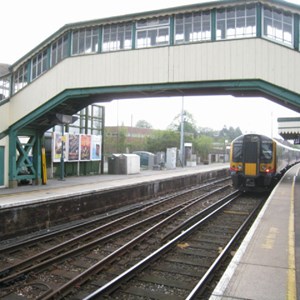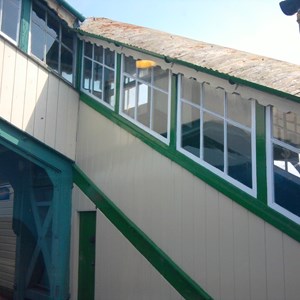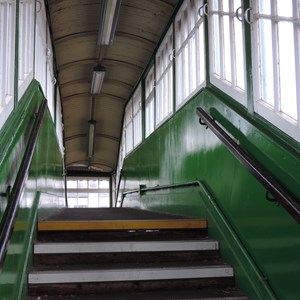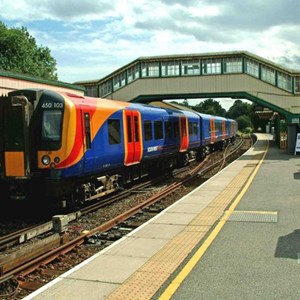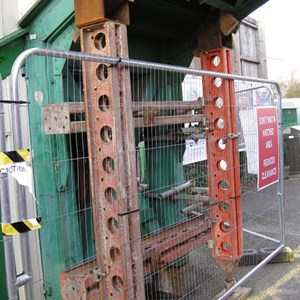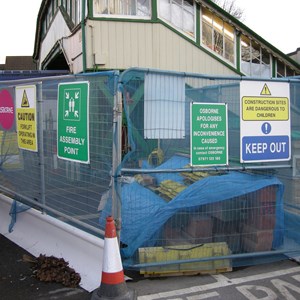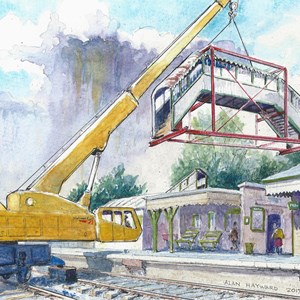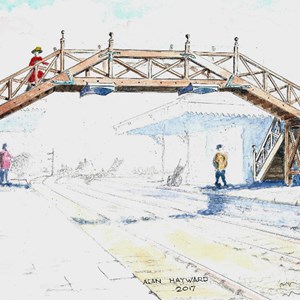Restoring 1892 Footbridge
Restoring the 1892 Footbridge at Alton Station
This bridge was, until 2013, the only way to cross the tracks at Alton Station to get to platforms 2 and 3. In a joint project, Network Rail and South West Trains spent £1.7million in 2013 to build a new bridge with lifts, making a big difference to the many wheelchair users in the area. The problem for Alton was that the assumption was that the original historic bridge would be demolished. A group of local residents felt that something should be done to retain the bridge and this led to the formation of Friends of Alton Station as a steering group in 2014.
Our argument for keeping the bridge in situ was:
- It is a authentic structure that leads people to and from the Mid-Hants Railway / Watercress Line. The steam railway is one of the main tourist attractions for Alton, so the footbridge is both a metaphorical and real bridge from the railway into Alton, helping our local economy.
- Alton station is the start of the line to London and Guildford, and the bridge offers covered access between platforms and out of the station building.
- The bridge is part of Alton's heritage and is the only surviving example of this type of footbridge. Originally an open bridge, it was first roofed and then fully enclosed, making it unique.
This project has been long and slow to progress, requiring a lot of patience and staying power. Initially things looked bright; Network Rail agreed to keep the bridge in situ and then commissioned a visual survey to establish what work needed doing in the short term to enable the bridge to remain in use. The report was issued in April 2015 (see report below) and having agreed the funding, Network Rail started work on renovation in July 2015. Within a short while it was clear to the workmen that there were many more underlying structural faults than the visual survey had identified - so serious that they decided that the bridge had to be closed. This was a real setback.
A second survey was commissioned by Network Rail, this time looking behind panels and literally digging into the wood to find out where the rot and deterioration was located. The report was issued on 17th September 2015 (see report below), the day that we launched Friends of Alton Station (FAS) as a membership organisation.
Once the 2nd survey had been issued there was internal discussion within Network Rail to agree the funding within their budgets and again the contractors were given the green light to continue with the repairs. On 30th November 2015 scaffolding appeared and we soon heard that the contractors (Osborne) had sent off for Canadian Spruce to enable them to make the structural repairs. The wood arrived, but no work was undertaken because they had found even more structural problems and all works stopped.
Finally, after a long and ominous silence, on 30th April 2016 we received a copy of an internal Network Rail memo. They offered a projected cost of £750k for the repairs to the footbridge, whilst suggesting a budget of up to £250k for removal and the provision of a new platform canopy to lead up to the new footbridge. The case for removal is obvious in financial terms, so the engineers had therefore concluded that the bridge should be removed.
Naturally FAS was greatly concerned and eventually our Chairman had a call from the Wessex Route Asset Manager who was talking about resolving the issue within six months. We eventually met two representatives of Network Rail on 15th June 2016 and somewhat reluctantly agreed that by 31st December 2016 we would attempt to offer proof that we could source funds to repair/restore the footbridge. They were saying that if we failed in this task, then the bridge removal will go ahead as planned. In order to start the process, we decided that we needed to do three things: we applied to get the footbridge listed, we started an online petition (two in the end) and we commissioned a structural engineering report. More of this below.
The Change.org petition gained 1,116 signatories, whilst the later 38degrees.org.uk petition got a further 199 signatures. Although encouraging, we realised that the petitions alone would not change the minds of Network Rail. However, it demonstrates that there are a good number of people locally, nationally and internationally who value the heritage footbridge. Although the petitions are no longer live, we have collected everyone's comments and have them on file. Thank you to everyone who signed them, especially so if you left a comment.
We have tried to get the footbridge listed on two separate occasions. The first time, in 2014, the application was made by Nick Carey-Thomas (Alton Society) and he was encouraged by English Heritage to list the whole station - it was turned down. In 2016 Nigel Welbourn tried again on our behalf, this time limiting the listing to just the footbridge, but again it was turned down. We appealed against this latter determination in October 2016 and we finally got an answer in October 2018 (yes, two years later!!!) saying that the earlier decision stands.
At this point it is worth making an aside to explain that between our two applications, the listing process was moved to a new body called Historic England. This was set up in 2015 to take on the statutory roles formerly undertaken by English Heritage, whilst English Heritage has become a charitable trust in charge of the buildings originally collected on behalf of the nation by the Office of Works (later the Ministry of Works).
In our opinion, it would appear that Historic England and the Department for Culture, Media & Sport (DCMS) were desperate not to list the footbridge. If you read their reasons for turning down the application, they were not offering a coherent argument for their decision. We appealed against their decision, but after two years the appeal was rejected. We discovered that the appeal process does not involve an independent arbitrator or ombudsman, not to mention the fact that all but one of the staff had been seconded into the Department for Exiting the European Union. Both of the listing 'determination' documents are below for you to read.
In another odd twist to this tale, we were originally asked by Network Rail not to get the footbridge listed (although at the time of asking the first application had been made). This was because a listed structure is much harder to restore because of all the protections conferred upon it, requiring more expense and paperwork. At the time, Network Rail were going to pay for the repairs out of their reserved demolition budget. Moving forward to 2016, we were asked to stump up the money to pay for the restoration and in 2017 we wrote to the Railway Heritage Trust to ask for funding. They manage a fund derived principally from Network Rail reserved for funding repairs to historic railway structures. They have denied us funding because the structure is not listed. It's a catch 22 that became a real problem for us.
In November 2016, local historian Jane Hurst found two letters published in the Alton Gazette of 1894 corroborating the story about the ladies of Alton who petitioned the LSWR to have the footbridge covered. We thought that this new information was significant because the 2nd listing application argued that this formed part of the social history of the women's rights movement. The listing determination dismisses this as an unsupported fact, but now we have the proof. The full text of the letter, along with many other interesting related information, is on the Ladies of Alton page of this website.
We realised that if we were going to seek donations and grants from funding bodies, we need to fully assess the condition of the footbridge. We commissioned our own structural engineering analysis from a company called Integral Engineering Design (IED) to get a fuller picture about the practicalities of repairing the bridge. This part of the project was led by committee member Paul Ebbutt who just happens to be a retired railway and structural engineer. We also have timber structures expert Gary Appleton on our team - he has worked on repairs to HMS Victory amongst other things. IED sent an engineer to look at the bridge inside and out, and this was followed by a report. Paul Ebbutt then wrote his own professional report, including the IED report as an appendix, to look at the wider considerations for the footbridge. This can be downloaded directly HERE or from the link at the bottom of the page. The IED engineering report was funded by membership subscriptions, donations (including Waitrose and the Alton Society) and grants from East Hampshire District Council. Our thanks go to all those who have provided financial support.
We met a representative of Network Rail in February 2017 and the result of that was that Network Rail decided that our lack of funding at that stage meant that, in their eyes, we had failed. Shortly after the meeting we received a substantial donation pledge, buoying our spirits, and we relayed this to Network Rail. Despite this good news, we received a letter in March 2017 from Network Rail to say that they plan to remove the footbridge in April 2018 (a deadline later extended), giving us a year to take action. Strangely this did not dent our enthusiasm - it simply made us more determined to succeed.
It was about this time that we were contacted by a very experienced and well-known retired bridge engineer Alan Hayward. His practical input has helped us to see that the seemingly impossible is possible. He has been able to study the ways that the bridge section could be lifted, including looking at the various cranes and land available for setting it to one side.
As well as being an engineer, Alan is also an artist, and below we see two of his paintings. The left-hand picture shows his proposal for lifting out the centre section of the footbridge using a rail-borne crane. The right-hand image shows how the bridge might have looked when first installed in 1892, before the roof and windows were added.
Alan's proposal for the removal of the bridge section was given to Network Rail and their contractor priced it at £130,000 as an 'extra over' to the budget for removal. This price was quoted to us at a meeting with Network Rail people in November 2017 - at the same time they said that they could delay removal until October 2018. Even with the extra time, we felt that it was a very high target for us to meet. We later had the opportunity to inspect the proposed site for relocating the bridge section and we realised that it wasn't really suitable, at least not without a lot of extra expense to prepare the site.
It was at this point that our timber structures expert, Gary Appleton, proposed that we lift out the bridge using a road crane (with no cradle), then dismantle it immediately in the car park and store the parts off-site. We were foolish enough to think that this could be achieved within Network Rail's demolition budget. We met the Network Rail team again in April 2018 so that we could look inside the footbridge. It was at this point that they said that the date for removal had been moved to February 2019. We introduced the new plan for removal, but it later transpired that this was not recorded or considered.
With such a large sum to raise, we took a gamble that we could find a commercial sponsor by taking a stand at the three-day 'Timber Expo' at the Birmingham NEC. As time wore on, we realised that the exhibition costs were going to be far too great for us and we were advised that the sort of companies attending were unlikely to be interested in sponsoring a project like ours. We therefore pulled out.
In October 2018 we met Network Rail representatives and they reiterated that they still wanted £130k for 'extra over' costs to facilitate careful removal. Only then did they register that we are proposing a cheaper method of removal. In 2019 were able to secure a £50k grant from the Railway Heritage Trust (part of Network Rail), but of this, £35k went back to Network Rail to cover undisclosed extra costs involved in removing the bridge "carefully". At our request they spent a further £2,500 on a 3D laser scan, leaving as around £11,000 to spend on transporting the bridge to its storage site. The bridge was removed on the 7th March 2020 (minus the side stairs) and it stood under tarpaulins at Brant Storage until the end of January 2022. We then contracted Green Oak Carpentry to carefully dismantle it so it can be stored ready for restoration.
At the behest of the Railway Heritage Trust, in 2019 we changed our organisational status from an unincorporated association to that of a company limited by guarantee, called Friends of Alton Station Ltd. However, our plan now is to pursue our original intension to register a charity (CIO) dedicated to the footbridge restoration.
We are adamant that we will succeed, but we need you to help us. Please give generously.
For historic information about the bridge, see the 'Footbridge History' page.
